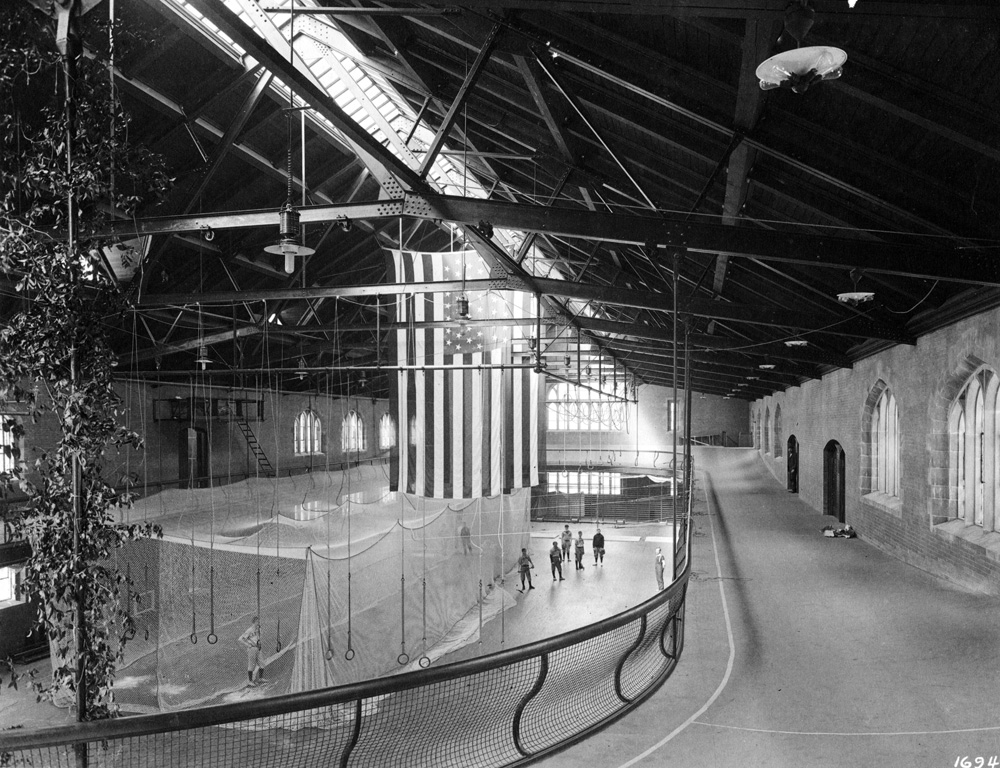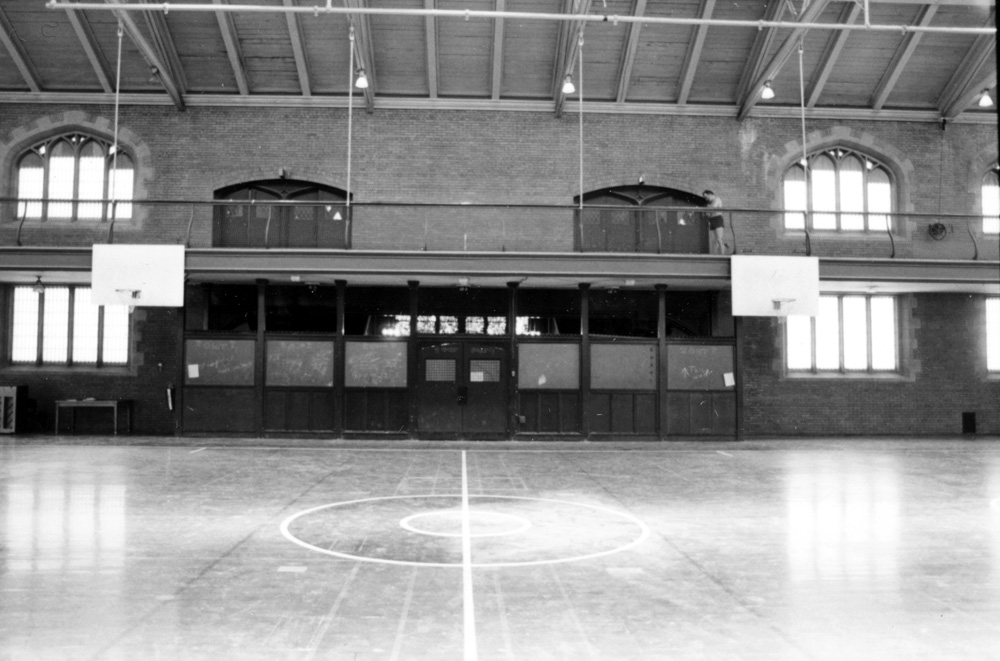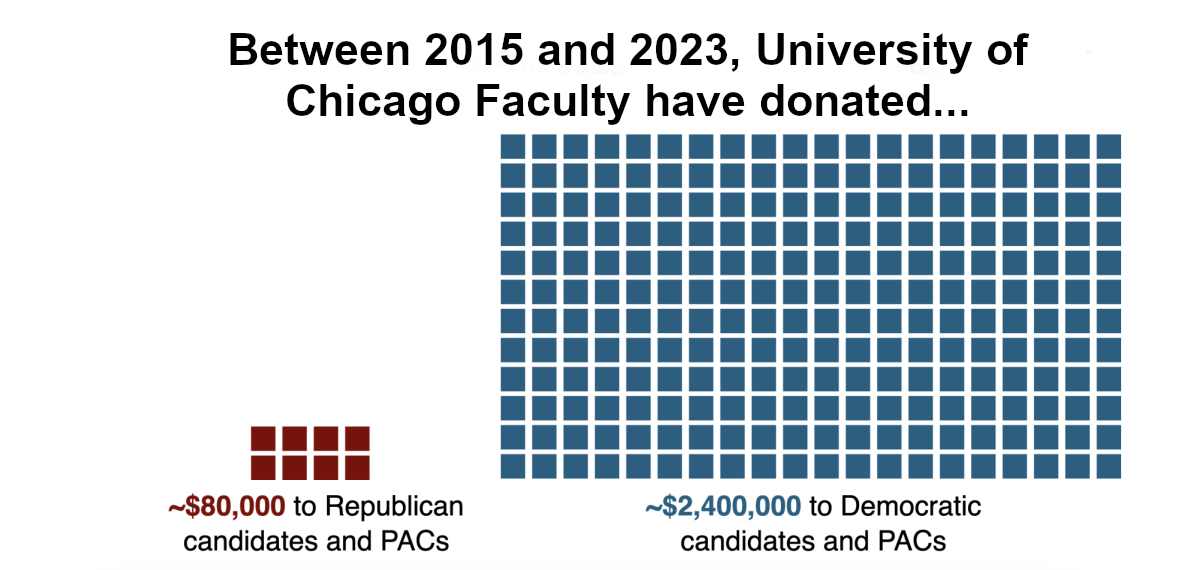On a frigid January day during Chicago’s coldest winter on record, varsity athletes with the letter “C” emblazoned on their jackets shuffled across the street from the annual football dinner to attend the opening ceremony of Frank Dickinson Bartlett Gymnasium. Music from the University Military Band drifted down from the elevated track as the athletes assembled, joining a procession of student council members, faculty, and trustees. The maple floor of the basketball court shone underfoot. The polished brass gymnastics equipment, which complemented the building’s Gothic architecture, gleamed. Trustee Adolphus Bartlett had spared no detail in the three-year construction of the gymnasium, erected as a memorial to Bartlett’s son and as a symbol of the University’s mission to nurture the body, mind, and spirit.
1,000 people clustered in the second story in eager anticipation of the opening speeches. University President William Rainey Harper had hoped to build a gym since 1892 and, now, a dozen years later, this dream was coming to fruition.
“The longer a prediction is delayed in its fulfillment, the larger and more glorious is the outcome when it is actually realized,” Harper said with pride. “These remarks are intended…for the encouragement of those heads of departments who still await, though not too patiently, the fulfilment of other predictions.”
Barely a decade old at the time, the University was perpetually strapped for cash. However, Harper saw the facility’s completion as evidence that he was able to make good on promises, placating other faculty eagerly awaiting adequate facilities.
Harper considered the gym worth the wait. “This building is, or ought to be, the best and most efficiently equipped gymnasium in the country,” he said. Amos Alonzo Stagg, the head of the athletics department, agreed.
“Tonight, we are in a palace—a perfect dream of a gymnasium, the best in the world,” Stagg said.
Adolphus Bartlett, a successful industrialist and chair of the University’s Committee on Finance and Investment, had fully financed the construction of a men’s gym in memory of his son, Frank Bartlett, who died from appendicitis at 20 years old. In his speech, President Harper declared that the gym would “stand for centuries, let us hope, as the memorial of a father’s love seeking to strengthen other fathers’ sons.”
Given its dual purpose as a memorial and a gym, the building had a kind of a spiritual quality. Bartlett, for his part, described the gym as “the fruition of a young life—a life in which good fellowship, truth, high aspirations, and kind deeds were the cardinal principles.”
Moreover, administrators commissioned the gym with a specific conception of manhood in mind: one based on leadership, obedience, and strength, which pastor and University lecturer Frank Gunsaulus considered “the type of manhood most needed today…. [It] had fine promise in Frank Bartlett; he was an obedient and law-abiding youth.”
Even the building’s English Gothic architecture was designed to reflect these values so that, in the words of the architecture firm, “in the Gymnasium the masculine character [is carried out] in its strength and solidity—ideas so fitting in a men’s athletic building.”
People at the turn of the 20th century regarded athletics as a means to further train the mind, and considered control over the body as an admirable signifier of mental command. Harper alluded to this idea in his speech, saying the gym held the “responsibility for the life and health, yes, and for the character, of the young men” at the University. For Harper and his contemporaries, sports were a means of ensuring intellectual diligence, not a frivolous or purely recreational activity.
Gunsaulus proclaimed, “Let this building be a temple in which men shall learn that each man’s body is so far the servant of the soul.”
In the case of the University, Gunsaulus saw the physical discipline of scholars who would eventually lead society as a way to further law and order in the world.
“The hour has come when the athletic man, having obeyed the law that he might obtain liberty and mastery over himself, shall be the obedient son and guardian of all law and the champion and defender of all order…. If the student and scholar are not to incarnate law and order, what may we expect of the untrained minds of a fierce democracy?”
By encouraging discipline, the gym contributed to the University’s mission of educating the whole person in order to impact society, one of the foundational and distinctive characteristics of the University at its inception. According to the dean of the Divinity School at the time, Eri Baker Hulbert, “among the regulations under which the University opened was one requiring attendance at chapel, class-room, and gymnasium.”
Most other higher education institutes at the time did not have compulsory physical education, but, at the University of Chicago, it was institutionalized rather than extracurricular. In his 2005 annual address, Dean of the College John Boyer noted how this emphasis on athletics and physical education was unique to the University in that the school “imposed faculty control over the athletic program which heretofore in many institutions had been left in the hands of students and alumni.”
Despite being an important part of the school’s identity, the focus on athletics was not without controversy. Boyer noted that, as early as 1900, there was “a significant group of faculty who believed…‘the present increasing interest in athletics in the University is undesirable.’” The movement away from the idea that sports and academics were mutually beneficial would culminate under President Robert Maynard Hutchins’s leadership decades later.

However, at the turn of the 20th century, Harper pressed the importance of sports in the life of the University. He was loyal to his close friend Stagg, head of the athletics department, but also encouraged athletics as a way to facilitate community. He envisioned that, with increased unity and collegiality among the students, alumni would be more inclined to donate. Sports provided a critical avenue to this kind of donation, particularly during the school’s financially vulnerable nascent period.
Boyer noted these phenomena in his *The University of Chicago: A History*. The University’s flexible quarter system allowed students to matriculate and graduate at any point in the year, creating a “loss of class identity among graduating seniors and, thereafter, among the alumni…. This, in turn, created serious problems for Chicago’s future success in development and fund-raising.” To mitigate this, Harper set about “exploiting the University’s newfound athletic prowess to cultivate wider civic and alumni support.”
Though this sports-oriented focus created controversy, the physical education component of the Core curriculum distinguished the University from many other institutions at the time, and well into the 21st century. In 2012, the athletics department elected to eliminate the swimming proficiency test, general fitness test, and mandatory P.E. requirement for students who did not place out. Since then, the athletics department has shifted its energies into expanding extracurricular programs such as cardio kickboxing, yoga, and Zumba as a way of exposing UChicago students to sports.
Bartlett also underwent a number of changes between its opening and the elimination of the physical education requirement. While, in the first decades of the 20th century, Bartlett’s single basketball court had served as the home for Division I games, by 1931, competitive sports had moved into Henry Crown Field House’s expanded facilities. Gone were the days when Edwin Hubble of the Hubble telescope played varsity basketball on its polished floors or when former senator Charles Percy played water polo in its basement pool. Instead, Bartlett became the hub of men’s intramural and recreational sports activities on campus, including club badminton and handball.
At the same time as Bartlett was transforming into a recreational facility, the University’s attitude toward sports was shifting drastically under Hutchins. Highly critical of the expansive football program, Hutchins called it “an infernal nuisance” in a 1954 essay for *Sports Illustrated* and, unlike Harper, did not consider it necessary to attract donations.
“Students will come to college to study. Alumni will believe that this is something a normal, red-blooded, young American can properly do. Donors will understand that they are asked to support the institution, not because it has succeeded in attracting a few boys who are huskier and faster than those representing another college, but because when they give it, their money will be well spent in improving education and advancing knowledge,” Hutchins said of the effects of eliminating Chicago’s football team.
By 1970, this academic mindset was firmly in place. Rosalie Resch, now senior associate director of athletics for budget and finance, was entering her second year at the College as the Regenstein Library emerged from the grounds where a football field had once stood.
As a woman, Resch’s experience of sports at the University was quite different. Resch remembered that women did not use Bartlett’s facilities until the late 1970s.
“When I came here, the men’s and women’s physical education departments were separate departments,” she said.
Nonetheless, women could access athletic facilities in Ida Noyes Hall, which, since its 1914 opening, had been the “social and athletic center for women students at the University,” providing a space for a dining hall, clubrooms and a gymnasium complete with a swimming pool.
However, “a lot of women wanted to swim at Bartlett,” Resch recalled. As they were constructed in the early 20th century, both pools were somewhat antiquated.
“The swimming pool in Bartlett was a slightly better bad swimming pool,” she said.
The Bartlett pool was deeper and had better hours because Ida Noyes’ pool was frequently closed for physical education swimming classes. Resch recalled, “a group of women, I’ll always remember their name, the Women Organized for Locker Facilities—the WOLF group—banded together to push for the provision of locker facilities for women in Bartlett.”
Bartlett had no women’s locker rooms and only one women’s restroom at the time. The men’s locker room was directly attached to the building’s only shower room, presenting a significant logistical challenge in adapting the facilities. Nevertheless, extensive renovations took place to add women’s locker rooms to Bartlett.
In addition to the infrastructural challenge, a cultural shift also had to take place. Though Resch did not recall significant opposition to women using the facility, “the men were very used to swimming in the nude,” she said. “They had to retrain the men to put on swimsuits.” Some men also raised concerns about the swimming pool becoming too crowded.
After the passage of Title IX, which prohibits discrimination on the basis of sex in educational settings, the University had to adapt its athletics programming along with the rest of the country to ensure equitable sports participation and scholarship opportunities.
“Things changed very, very quickly in a very, very short period of time after Title IX was passed,” Resch said.
The two athletics departments merged in 1976 and eventually came to inhabit offices in Bartlett, which became the department’s administrative center in addition to the center of student recreation.
The Bartlett pool was deeper and had better hours because Ida Noyes’ pool was frequently closed for physical education swimming classes. Resch recalled, “a group of women, I’ll always remember their name, the Women Organized for Locker Facilities—the WOLF group—banded together to push for the provision of locker facilities for women in Bartlett.”
Bartlett had no women’s locker rooms and only one women’s restroom at the time. The men’s locker room was directly attached to the building’s only shower room, presenting a significant logistical challenge in adapting the facilities. Nevertheless, extensive renovations took place to add women’s locker rooms to Bartlett.
In addition to the infrastructural challenge, a cultural shift also had to take place. Though Resch did not recall significant opposition to women using the facility, “the men were very used to swimming in the nude,” she said. “They had to retrain the men to put on swimsuits.” Some men also raised concerns about the swimming pool becoming too crowded.
After the passage of Title IX, which prohibits discrimination on the basis of sex in educational settings, the University had to adapt its athletics programming along with the rest of the country to ensure equitable sports participation and scholarship opportunities.
“Things changed very, very quickly in a very, very short period of time after Title IX was passed,” Resch said.
The two athletics departments merged in 1976 and eventually came to inhabit offices in Bartlett, which became the department’s administrative center in addition to the center of student recreation.
However, as the College continued to expand its enrollment, particularly in the 1990s, Bartlett became inadequate to meet the increasing athletic demands of the student body, prompting the need for renovation.
For example, Resch noted the rising popularity of the department’s FitChicago classes as well as the “very active” clubs program. She attributed this change to the observation that, “across the country I think there’s much greater awareness for young people to understand the benefits and values of regular activity, stress reduction.”
It was a swing back to Stagg’s conviction that “men’s best efforts do not spring forth when they are in a low condition of physical life…. Raise the standard of health and you will raise the quality and widen the breadth of achievement.” This increased popularity of athletic facilities on campus further tested Bartlett’s capacity.

As a result of the building’s physical limitations, Bartlett was not updated for continued use as a gym facility, and Henry Crown became the main athletic space on campus.
“The space of the second floor wasn’t big enough to do two courts.… It really could only accommodate one group and set of activities at one time,” Resch said.
Bartlett’s 2001 transformation into a dining hall was just one aspect of a broader $500 million campus master plan to “substantially improve” facilities. This development goal, announced in a 1999 press release, coincided with updated enrollment goals in 1996, which ultimately enlarged the College to 4,500 undergraduates. Bartlett’s conversion from a gym to a dining hall, the creation of Gerald Ratner Athletics Center, and the construction of Max Palevsky Residential Commons were all elements of the University’s effort to attract more applicants and to accommodate the expanded undergraduate presence.
While community, both within the College and beyond, remained an important goal, the means of attaining it had shifted. In his 2005 address reflecting on the renovations and his vision for the College’s future, Boyer argued that “a more strongly residential campus would be a real asset to the University, both by encouraging stronger communities among our students and reinforcing student morale and by encouraging greater alumni satisfaction.” In contrast to Harper’s emphasis on sports as the means to achieve unity, Boyer envisioned the strengthening of the residential college system as the best way to boost student satisfaction.
Bartlett was converted into a dining hall for the new dorms, whose suite-style design and splashy colors were also meant to encourage sociability and cheerfulness.
Upon its reopening in January 2002, Bartlett, at twice the size of other campus dining halls, was able to serve more than 1,000 students. This consolidation of students into a shared, central space further supported the expansion of residential life, which administrators hoped would create a more unified social atmosphere.
Today, many physical features of Bartlett’s past remain. The brass rivulets where parallel bars and vaults fit into the floor are still visible to diners at the taco station, and the running track remains overhead, retrofitted with outlets. The gym’s old scoreboard, “a monument to the building’s past,” is visible among the banners marking house tables.
Downstairs, the mural, “Athletic Games in the Middle Ages,” still proclaims “the glory of manly sports,” making an idiosyncratic feature of many prospective students’ tours on campus. Along the wood-paneled hallway, members of Delta Upsilon have, in recent years, added their own athletic victories to the gold-lettered lists of fraternity victories.








